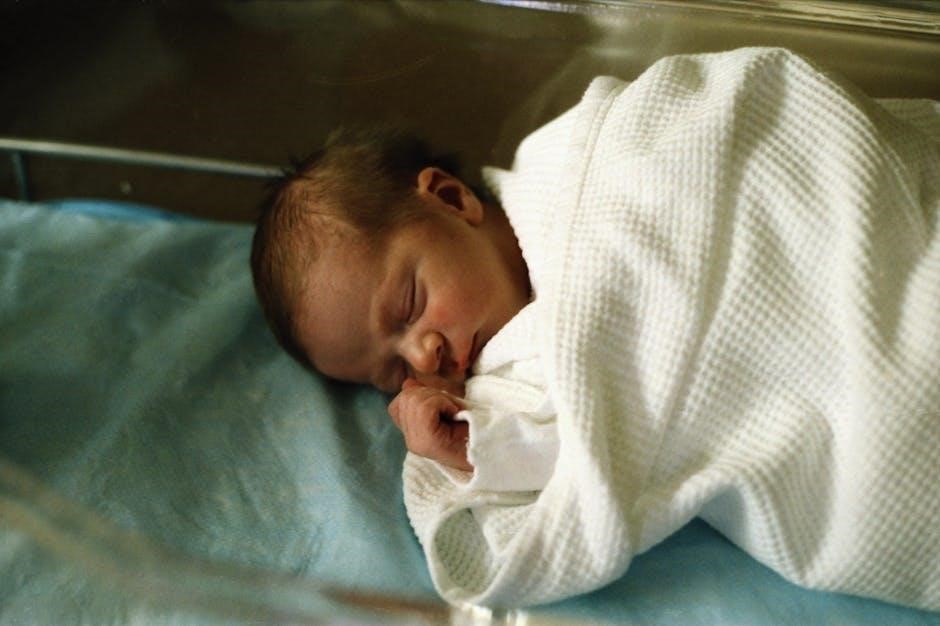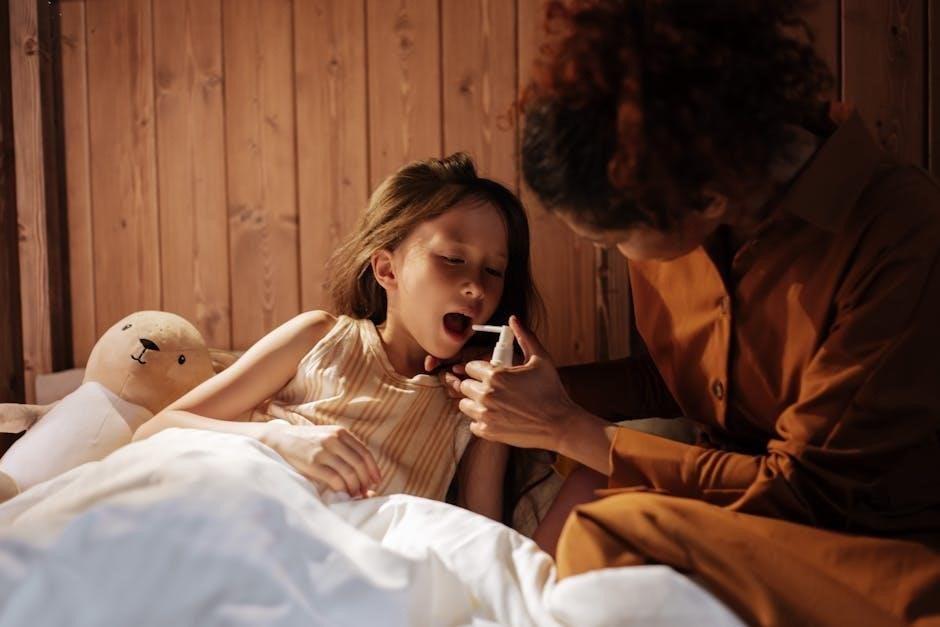The Pediatric Sleep Questionnaire PDF, utilizing the BEARS tool, is a vital resource for assessing sleep disturbances in children, promoting early intervention and healthier sleep patterns.
1.1 Overview of the BEARS Sleep Screening Tool
The BEARS Sleep Screening Tool is a user-friendly, 5-item questionnaire designed to identify sleep problems in children aged 2 to 18 years. It is divided into five key domains represented by the acronym BEARS: Bedtime Issues, Excessive Daytime Sleepiness, Awakenings at Night, Regularity of Sleep, and Snoring. Each domain includes age-appropriate questions to assess common sleep disturbances. The tool is quick and practical, making it ideal for use in primary care settings. It helps healthcare providers detect potential sleep issues early, enabling timely interventions. The BEARS tool is widely recognized for its effectiveness in clinical applications and has been validated in studies, such as those by Owens and Dalzell, demonstrating its value in promoting healthy sleep habits in pediatric populations.

1.2 Importance of Sleep Assessment in Pediatrics

Sleep assessment is critical in pediatrics, as adequate sleep is essential for children’s cognitive, emotional, and physical development. Sleep disturbances can lead to attention deficits, behavioral problems, and impaired academic performance. Untreated sleep issues may also contribute to long-term health complications, such as obesity and cardiovascular problems. Early detection of sleep disorders through tools like the BEARS Sleep Screening Tool enables timely interventions, improving overall well-being. Sleep problems often go unnoticed, making systematic assessment vital in pediatric care. By identifying sleep-related concerns, healthcare providers can guide families in establishing healthy sleep habits, fostering better developmental outcomes and quality of life for children.

Structure and Components of the BEARS Questionnaire
The BEARS Questionnaire is structured into five domains—B-E-A-R-S—each addressing specific sleep concerns with age-appropriate questions for toddlers, school-aged children, and adolescents.
2.1 The Five Domains of Sleep: B-E-A-R-S
The BEARS Questionnaire is structured around five key sleep domains, represented by the acronym B-E-A-R-S. Each domain focuses on specific sleep-related concerns.
– B (Bedtime Issues): Assesses difficulties in falling asleep or resistance to bedtime routines.
– E (Excessive Daytime Sleepiness): Evaluates daytime tiredness or inappropriate sleeping during the day.
– A (Night Awakenings): Explores frequent nighttime waking or disrupted sleep patterns.
– R (Regularity and Duration of Sleep): Examines consistency in sleep schedules and whether sleep duration meets age-appropriate norms.
– S (Snoring): Screens for breathing difficulties or loud breathing during sleep, which may indicate sleep apnea.
These domains provide a comprehensive framework for identifying sleep problems in children aged 2–18 years, ensuring targeted and effective assessment.
2.2 Age-Specific Versions for Different Pediatric Groups
The BEARS Sleep Questionnaire is tailored to meet the needs of different pediatric age groups, ensuring age-appropriate assessment. It is divided into three versions:
– Toddler/Preschool (2-5 years): Focuses on bedtime struggles, nighttime awakenings, and sleep duration, with simple, direct questions for parents.
– School-Aged (6-12 years): Includes questions about daytime sleepiness, sleep schedule consistency, and snoring, reflecting older children’s sleep patterns.
– Adolescent (13-18 years): Addresses sleep issues unique to teens, such as bedtime resistance, excessive daytime sleepiness, and sleep irregularity due to lifestyle factors.
This age-specific approach ensures the questionnaire remains relevant and effective for diverse developmental stages, aiding clinicians in identifying sleep problems accurately. Each version adapts to the unique challenges of sleep in different age groups.

Administration and Interpretation Guidelines
The BEARS tool is administered in clinical settings, taking 5-10 minutes to complete. Clinicians review responses, identifying sleep issues based on affirmative answers and guiding further evaluation.
3.1 How to Use the BEARS Instrument in Clinical Settings
The BEARS instrument is designed for easy integration into clinical workflows. Clinicians administer the tool by asking age-appropriate questions across the five sleep domains (B-E-A-R-S). For each domain, specific triggers are used to assess issues like bedtime resistance, excessive daytime sleepiness, or night awakenings. The screening typically takes 5-10 minutes, making it efficient for primary care visits. Responses are reviewed to identify patterns or concerns. Positive responses should be discussed with the healthcare provider to determine the need for further evaluation or referral to a sleep specialist. This streamlined approach ensures early detection and management of pediatric sleep problems, improving overall patient outcomes; Regular use of the BEARS tool in clinical settings enhances sleep health monitoring and promotes timely interventions.
3.2 Interpreting Responses and Identifying Sleep Issues
Interpreting BEARS responses involves reviewing answers across the five sleep domains (B-E-A-R-S) to identify potential sleep concerns. Positive responses, such as “yes” answers, indicate areas that may require further evaluation. For example, bedtime problems or excessive daytime sleepiness could suggest underlying issues like insomnia or sleep apnea. Clinicians assess the severity and frequency of symptoms to determine if a referral to a sleep specialist is necessary. The tool’s age-specific questions help tailor interpretations to developmental stages, ensuring accurate identification of sleep disturbances. By systematically analyzing responses, healthcare providers can address sleep issues early, improving children’s overall health and well-being. This structured approach ensures consistent and reliable identification of pediatric sleep problems.

Clinical Applications and Case Studies
The BEARS tool has been effectively used in clinical settings to identify sleep disorders in children, as demonstrated in studies like Owens and Dalzell’s pilot study.
4.1 Representative Studies Using the BEARS Scale
Several studies have demonstrated the effectiveness of the BEARS scale in identifying pediatric sleep issues. A pilot study by Owens and Dalzell (2005) highlighted its utility in clinical settings, while Beebe’s research showcased its reliability across diverse age groups. These studies emphasize the tool’s ability to detect bedtime problems, excessive daytime sleepiness, and sleep disruptions. For instance, the BEARS scale was instrumental in identifying sleep apnea and insomnia in children, enabling early interventions. Such research underscores the scale’s practicality and effectiveness in pediatric care, making it a valuable resource for clinicians and researchers alike.
4.2 Practical Examples of the Questionnaire in Action
The BEARS questionnaire has been successfully applied in various clinical settings to identify and address sleep issues in children. For instance, in a pediatric clinic, the tool helped detect bedtime struggles in a 4-year-old, leading to tailored interventions. Similarly, a school-aged child exhibiting excessive daytime sleepiness was evaluated using the BEARS scale, revealing underlying sleep apnea. In another case, the questionnaire identified night awakenings in an adolescent, prompting further investigation into sleep environment factors. Such real-world applications demonstrate the questionnaire’s effectiveness in guiding targeted interventions, improving sleep quality, and enhancing overall pediatric care. These examples highlight its practical utility in addressing diverse sleep-related challenges in children.

Promoting Healthy Sleep Habits in Children
Establishing consistent bedtime routines, creating a calming sleep environment, and using tools like the BEARS questionnaire can help identify and address sleep issues early, fostering better sleep quality in children.
5.1 Bedtime Routines and Sleep Environment Tips
Establishing consistent bedtime routines is crucial for promoting healthy sleep in children. Activities like reading, storytelling, or a warm bath can signal it’s time to sleep. Ensure the sleep environment is calming, dark, and quiet. Remove electronic devices, as screen time can disrupt sleep patterns. Maintaining a regular sleep schedule, even on weekends, helps regulate the body’s circadian rhythm. Parents should also encourage physical activity during the day and avoid stimulating activities before bedtime. Creating a soothing ambiance, such as using dim lighting or playing soft music, can further enhance sleep quality. These strategies, aligned with insights from the BEARS questionnaire, help identify and address sleep challenges early, fostering better rest and overall well-being in children.

5.2 Strategies for Addressing Common Sleep Problems

Addressing common sleep problems in children requires tailored strategies based on the insights from the BEARS questionnaire. Consistency is key; stick to regular bedtimes and wake-up times, even on weekends. Create a calming sleep environment by ensuring the room is dark, quiet, and cool. Limit screen time before bed, as it can interfere with sleep quality. Encourage physical activity during the day but avoid stimulating activities close to bedtime. For night awakenings or nightmares, establish a comforting routine to help the child fall back asleep. If sleep problems persist, consider consulting a pediatric sleep specialist for personalized guidance. These strategies aim to promote restful sleep and improve overall well-being in children.



